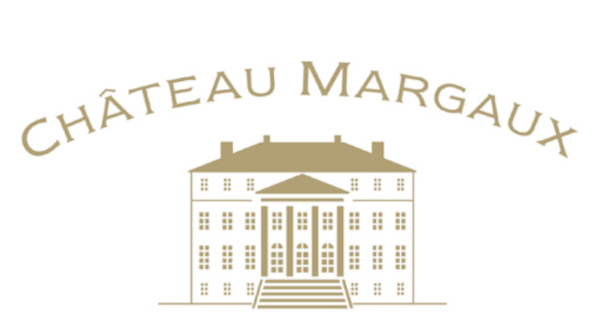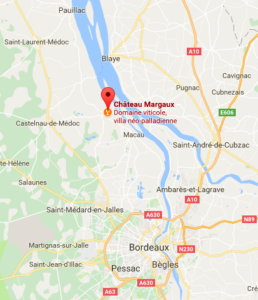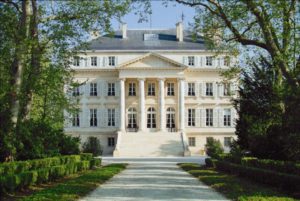 History
History

Known since the XII century when it was called “La Mothe de Margaux”, the property originally didn’t have any vines. The successive owners of “La Mothe de Margaux” were important lords, but it wasn’t until the arrival of the Lestonnac family that the estate began to look as we know it today. Between 1572 and 1582, Pierre de Lestonnac succeeded in completely restructuring the property as well as the vineyard. He anticipated the general evolution of the Médoc that had started to abandon cereal growing in favor of vines. At the end of the XVII century, Château Margaux occupied 265 hectares, land that wouldn’t be divided again. A third of the estate was dedicated to vines, which is still the case today.
Emperor Napoléon III paid an important service to the great red wines of the Médoc by organizing in Paris the Second Universal Exhibition in 1855. It was an occasion for him to glorify French products, among which were the prestigious Médoc wines. He wanted the wines to be presented in the form of a classification. A blind tasting was organized in Paris which led to this official classification in 1855. It divided about sixty Médoc growths, and a property in the Graves, into five quality levels. Four growths were classified “Premier Grand Cru Classé”; only Margaux was marked twenty out of twenty. This classification, which maintains its validity today, confirmed the qualitative hierarchy illustrated by the great price differences that had been practiced on the world market for a long time.
Fernand Ginestet and his son Pierre came on the scene. Fernand had made his fortune in wine trading. It was one of his friends, the Mayor of Saigon, and a wine importer who sent him the funds necessary to buy the estate. The Ginestet family acquired the whole property in about 1950. Fernand and Pierre patiently reorganized the vineyard. Pierre’s son, Bernard, looked after their trading business and developed one of the most respected wine trade establishments in Bordeaux. But the recession of the 1970s and the disastrous unsaleable vintages of 1972, 1973, and 1974 placed Pierre and Bernard in a desperate situation; nevertheless, they wanted to honor their commitments.
 Their only negotiable asset was Château Margaux that they resigned themselves to selling. It took two years for Pierre and Bernard Ginestet to sell Château Margaux and when André Mentzelopoulos bought the property in 1977, the Burgundy community was astounded. However, Mentzelopoulos succeeded in convincing even the most pessimistic doubters with his energy and clarity of vision which he poured into the revitalization of Château Margaux. With almost spectacular speed, he re-established the quality of the wine and the reputation of the estate.
Their only negotiable asset was Château Margaux that they resigned themselves to selling. It took two years for Pierre and Bernard Ginestet to sell Château Margaux and when André Mentzelopoulos bought the property in 1977, the Burgundy community was astounded. However, Mentzelopoulos succeeded in convincing even the most pessimistic doubters with his energy and clarity of vision which he poured into the revitalization of Château Margaux. With almost spectacular speed, he re-established the quality of the wine and the reputation of the estate.
Upon his death, André Mentzelopoulos’ daughter Corinne Mentzelopoulos was immediately ready for the challenge. At the time of her father’s death, she was already established in the family group as management controller at Primistères, the company that managed the Félix Potin company. Surrounded by the team that her father had chosen, she followed in his footsteps so that Margaux was ready to take up another challenge, that of the extraordinary explosion in worldwide demand for Bordeaux wines starting in 1982. The Americans were the first to get enthusiastic for the classified first growths, quickly joined by the more traditional connoisseurs in Great Britain and Germany, followed by the Japanese, enthusiasts in Hong Kong and Singapore, the Russians, the Chinese, the Indians, the Brazilians….
Bordeaux has been blessed with a succession of great vintages with the true pinnacle of success being the 2009 and the 2010. At the same time, the Félix Potin company was transformed, the stores and the property were given up, and the group – now called Exor – became the majority shareholder in Perrier, which was at the time the world market leader for mineral water. Corinne Mentzelopoulos decided to find support in the development of a group which it seemed unwise to manage alone. At the beginning of the 1990s, Corinne Mentzelopoulos found an associate in the Agnelli family, then directed by Gianni Agnelli, the president of Fiat. This association lasted about ten years and, in 2003, when the Agnelli Group decided to dispose of the Château Margaux shares, Corinne Mentzelopoulos bought them immediately, thereby becoming the only shareholder in the estate.

Château Margaux 1er Grand Cru Classé
Overview: Since the 17th century, the first wine of Château Margaux has been recognized as being one of the greatest wines in the entire world. It owes its unique qualities to the genius of its terroir as well as to the passionate work of a succession of generations. It’s a remarkable wine that comes from a combination of characteristics that are only rarely found: finesse, elegance, complexity, density, intensity, length and freshness. Although its tannic concentration may be exceptional, it’s rare to detect astringency.
The great vintages are distinguished by their formidable ability to move us. The lesser vintages give pleasure to wise enthusiasts. They offer the advantage of evolving very rapidly and, reveal, after a few years, instead of power, this subtlety that is the prerogative of great terroirs.
Château Margaux has an extraordinary ability to evolve. Over the years, it has developed a finesse, an aromatic complexity and a remarkable presence on the palate.
Grape Varieties: Cabernet Sauvignon, Merlot, Petit Verdot, and Cabernet Franc (percentages change depending on the vintage)
Vinification: Fermentation in oak barrels.
Aging: 18 to 24 months in new oak barrels. Fining with egg-white.
Annual Production: 130,000 bottles

Pavillon Rouge du Château Margaux
Overview: The production of a second wine probably goes back to the beginning of the XVII century because it is inseparable from the search for excellence which started at that time. Sold under the name of “Château Margaux 2nd wine”, it took its permanent name of Pavillon Rouge du Château Margaux in 1908. After an eclipse between the thirties and the mid-seventies, its production restarted on the arrival of André Mentzelopoulos in 1977 and at first greatly increased in order to improve the quality of the first wine. From the mid – 1990s, the creation of a third wine in its turn, allowed for a more and more rigorous selection for Pavillon Rouge. For a few years now, a third of the harvest has gone into the first wine, barely 30% into the Pavillon Rouge, and the remainder is divided between the third and fourth wines.
The quality of Pavillon Rouge has become very close to that of the first wine because all the plots involved contributed to the blending of Château Margaux not so long ago. Of course there isn’t the same complexity, the same depth, the same “magic” but the flavors are close and the balance in the mouth leads to the same subtle senses of power and softness. In general it is ready to drink a little earlier whilst retaining an excellent potential to age largely beyond 30 or 40 years.
Grape Varieties: Cabernet Sauvignon, Merlot, Petit Verdot, and Cabernet Franc (percentages change depending on the vintage)
Vinification: Fermentation in oak barrels.
Aging: 18 to 24 months in new oak barrels. Fining with egg-white.
Annual Production: About 100,000 bottles


